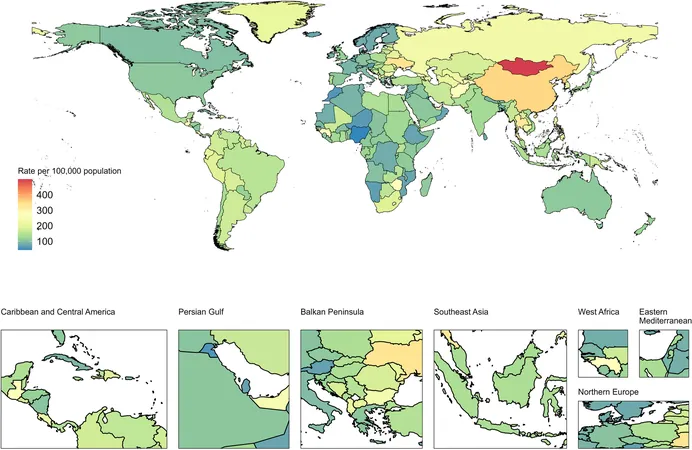
Alarming Increase in Gastrointestinal Cancers Among Youth: A Comprehensive Analysis from 1990 to 2019 with Dire Predictions for 2040
2024-11-28
Author: Wei
Overview of Gastrointestinal Cancer Burden in Adolescents and Young Adults
Recent studies reveal a troubling rise in gastrointestinal (GI) cancers among adolescents and young adults (AYAs) from 1990 to 2019, and predictions indicate a dramatic escalation by 2040. This alarming trend is backed by data from the Global Burden of Diseases (GBD) 2019 published in late 2020, which integrates vast datasets from various sources to estimate the burdens associated with 369 diseases, including GI cancers.
Understanding the Metrics and Methodology
The GBD employs crucial indicators such as incidence, mortality, prevalence, and disability-adjusted life years (DALYs) to gauge the impact of GI cancers on public health. Incidence measures new cancer cases during a specified timeframe, while mortality counts deaths attributable to these cancers. Conversely, prevalence refers to existing cancer cases at a certain point, and DALY is a composite measure that reflects years lost due to disease or disability.
Researchers utilize sophisticated statistical models to analyze and predict trends, including the Cause of Death Ensemble Model (CODEm) and Bayesian meta-regression (DisMod-MR), ensuring comprehensive assessment across varied data sources such as health registries, surveys, and civil statistics.
Insights from 1990 to 2019
The GBD 2019 data demonstrated a sobering reality: in 2019 alone, there were 171,857 new cases of GI cancers among AYAs. Notably, the most affected were those aged 35-39, with colorectal cancer (CRC), stomach cancer (SC), and liver cancer (LC) standing out as major contributors to the disease burden.
- **Colorectal Cancer (CRC)**: This cancer type accounted for 76,090 new cases, significantly contributing to DALYs, with high prevalence in high-SDI regions.
- **Stomach Cancer (SC)**: SC caused 49,008 new cases and showed a concerning trend, especially in low- and middle-SDI regions.
- **Liver Cancer (LC)**: With 25,430 new cases and notable death rates, LC poses a growing threat to AYAs.
Despite slight improvements in mortality rates over the years, the increasing prevalence of these cancers highlights the need for urgent interventions and awareness.
Predictions for 2040: A Stark Warning
The projections are grim. By 2040, the total number of new GI cancer cases among AYAs is anticipated to soar to 315,792, marking an 84% increase, with deaths expected to rise by 91%. Particularly worrisome is LC, which may see new cases skyrocket by nearly 2.55-fold, while SC remains the cancer with the least estimated increase.
For society to mitigate the impending surge effectively, annual reductions in cancer incidences and mortality rates must reach 1-3%, depending on the cancer type. Without coordinated preventive measures, including increased screening, awareness campaigns, and better treatment strategies, the burden of GI cancers will continue to increase exponentially.
Regional Disparities and Societal Implications
The study identified significant disparities across global regions. East Asia exhibited the highest incidence rates, while regions like Mongolia, Kiribati, and the Solomon Islands faced alarming rates of DALYs attributed to GI cancers. Such variations may be influenced by socioeconomic factors, including health policies, lifestyle choices, and access to healthcare.
As youth populations increasingly confront these pressures alongside mental health challenges and metabolic issues, resources may become strained. This underscores the urgency for targeted health policies and intervention strategies tailored to the unique profiles of these communities.
Final Thoughts
This comprehensive analysis sheds light on the burgeoning issue of GI cancers among young people, which has been insufficiently explored in existing literature. The increasing trend of CRC and other GI cancers emphasizes a critical need for enhanced awareness, early detection, and research into underlying causes to better inform health interventions.
Public health officials must prioritize addressing this alarming trend, ensuring that preventative measures are developed to combat the rising burden of gastrointestinal cancers among adolescents and young adults effectively. Without swift action, the implications for future generations could be dire.
 Brasil (PT)
Brasil (PT)
 Canada (EN)
Canada (EN)
 Chile (ES)
Chile (ES)
 Česko (CS)
Česko (CS)
 대한민국 (KO)
대한민국 (KO)
 España (ES)
España (ES)
 France (FR)
France (FR)
 Hong Kong (EN)
Hong Kong (EN)
 Italia (IT)
Italia (IT)
 日本 (JA)
日本 (JA)
 Magyarország (HU)
Magyarország (HU)
 Norge (NO)
Norge (NO)
 Polska (PL)
Polska (PL)
 Schweiz (DE)
Schweiz (DE)
 Singapore (EN)
Singapore (EN)
 Sverige (SV)
Sverige (SV)
 Suomi (FI)
Suomi (FI)
 Türkiye (TR)
Türkiye (TR)
 الإمارات العربية المتحدة (AR)
الإمارات العربية المتحدة (AR)